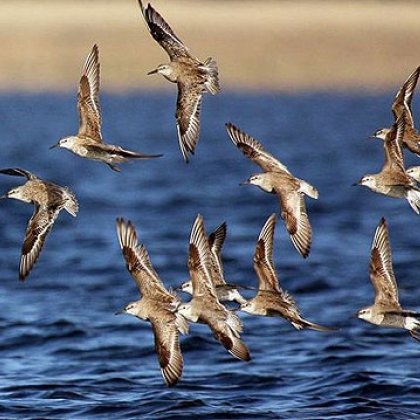
Millions of shorebirds and some species could be lost as sea levels rise in coming decades, say UQ scientists who are working as part of an international environmental team.
The group's world-first research predicts that a loss of 23 to 40 per cent of the birds’ main feeding grounds could lead to a 70 per cent decline in their populations.
This places some of the world’s shorebirds at greater risk as some areas have already reported population losses of 30-80 per cent.
“Each year, millions of shorebirds stop at coastal wetlands to rest and feed as they migrate from Russia and Alaska to the coasts of Southeast Asia and Australasia,” said Dr Richard Fuller of the National Environmental Research Program’s (NERP) Environmental Decisions Hub and The University of Queensland (UQ).
“We’ve discovered that some of these wetlands are highly vulnerable to sea level rise and might be lost in the next few decades. If the birds can no longer stop at these areas to ‘refuel’, they may not be able to complete the journey to their breeding grounds.”
The NERP researchers studied wetlands along the shorebirds’ migration route across coastal Alaska, Russia, China, North Korea, South Korea, Japan, Philippines, Vietnam, Thailand, Malaysia, Indonesia, Papua New Guinea, Australia and New Zealand.
In many cases rapid coastal development and reclamation are already chewing into the tidal wetlands the birds use as feeding grounds on their long journeys, which sometimes extend halfway round the world.
Species showing signs of being in trouble include the bar-tailed godwit, curlew sandpiper, eastern curlew, great knot, grey-tailed tattler, lesser sand plover, red knot and terek sandpiper.
The scientists used “graph theory”, a mathematical approach to estimate the impact of the loss of these wetlands on shorebirds.
“We found that if a tidal wetland habitat serves as an important ‘stepping stone’ for the shorebirds, a small amount of habitat loss can trigger disproportionally large declines in the population,” says Dr Takuya Iwamura of Stanford University, who conducted the research at NERP.
“This is because some of these tidal wetlands are ‘bottleneck’ sites where the majority of the birds stop to refuel.
“For example, we discovered that a sea-level rise of 150cm may result in the loss of 35 per cent of coastal wetlands, but it could lead to a 60 per cent decline in curlew sandpipers, eastern curlews and great knots.”
NERP scientists are also embarking on a second international study to identify the best ways to save the disappearing shorebirds. This research is crucial for federal policy because Australia has signed migratory bird agreements with China, Japan and South Korea.
“We’re aware that some shorebird species have declined in the past few decades, but we still know very little about all the causes for these declines or the scale of the problem,” said Mr Rob Clemens of NERP and UQ.
“Our studies attempt to piece together what is happening throughout the entire migration journey of these birds.
“We can then determine which species should be protected, how best we can monitor the birds, and where and how we should act to save them.
“While more knowledge would be useful, it’s important that we start protecting the birds based on what we already know, such as halting the reclamation of coastal wetlands in the vulnerable regions.”
UQ’s Dr Richard Fuller said huge areas of the world’s coastal wetlands had been reclaimed for urbanisation and agriculture in recent years, reducing the size of the wetlands available for migratory birds.
While some existing wetlands can shift inland as sea levels rise, sites along highly developed coastlines, for example in Japan, China and the Republic of Korea, cannot move at all because of the scale of human development close to the coast.
“While we can build sea walls to defend ourselves against rising sea levels, the cost of this will only increase as time goes by,” Dr Fuller said. “We could instead be looking for opportunities to return our coastlines to a more natural state.
“We must act now to protect these crucial ‘stepping stones’ for migratory shorebirds – if you lose one critical site, you risk losing the entire population of a species that stops there.”
The study Migratory connectivity magnifies the consequences of habitat loss from sea-level rise for shorebird populations by Takuya Iwamura, Hugh P. Possingham, Iadine Chadès, Clive Minton, Nicholas J. Murray, Danny I. Rogers, Eric Treml and Richard A. Fuller appears in the latest issue of Proceedings of The Royal Society B.
The Australian Government funds the National Environmental Research Program (NERP) to inform evidence-based policy and sustainable management of the Australian environment.
More information:
Mr Rob Clemens, NERP Environmental Decisions Hub and UQ, ph +61 (0)425 805 087
Dr Richard Fuller, NERP Environmental Decisions Hub and UQ, ph +61 (0)458 353 102 (US Pacific Daylight Time); r.fuller@uq.edu.au
Dr Takuya Iwamura, Stanford University, ph +1 415 852 1840 (US Pacific Daylight Time)
Professor Hugh Possingham, NERP Environmental Decisions Hub and UQ, ph +61 (0)434 079 061 (currently at Yale University, US eastern standard time); h.possingham@uq.edu.au
Karen Gillow, Science Communications, NERP Environmental Decisions Hub and UQ, +61 (0)7 3365 2450 or +61 (0) 402 674 409 or k.gillow@uq.edu.au
Fiona Cameron, UQ Communications, +61 (0)7 3346 7086 f.cameron2@uq.edu.au
.jpg)









